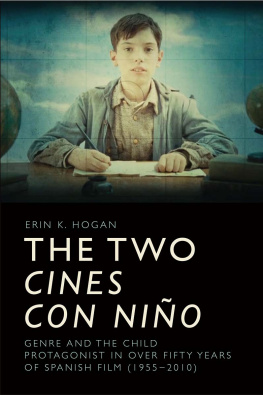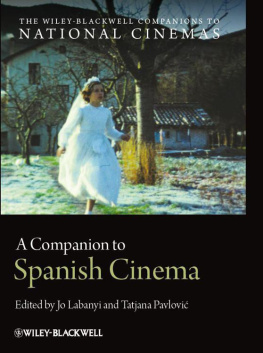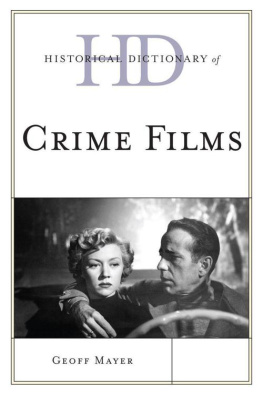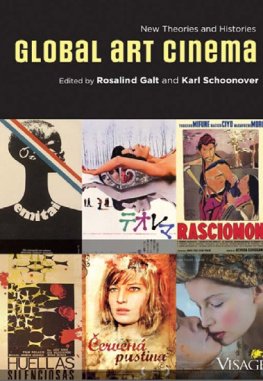
The Two cines con nio
The Two cines con nio
Genre and the Child Protagonist in over Fifty Years of Spanish Film (19552010)
Erin K. Hogan

Edinburgh University Press is one of the leading university presses in the UK. We publish academic books and journals in our selected subject areas across the humanities and social sciences, combining cutting-edge scholarship with high editorial and production values to produce academic works of lasting importance. For more information visit our website: edinburghuniversitypress.com
Erin K. Hogan, 2018
Edinburgh University Press Ltd
The Tun Holyrood Road
12 (2f) Jacksons Entry
Edinburgh EH8 8PJ
A CIP record for this book is available from the British Library
ISBN 978 1 4744 3613 7
The right of Erin K. Hogan to be identified as author of this work has been asserted in accordance with the Copyright, Designs and Patents Act 1988 and the Copyright and Related Rights Regulations 2003 (SI No. 2498).
Contents
Figures
Acknowledgements
On Rites of Passage
Writing a scholarly monograph is in many ways a rite of passage towards academic maturity. It has its preliminary, liminary, and postliminary steps and, whats more, missteps. Its a zig-zagging path that, for this monograph, has come to a conclusion thanks to the generosity and support of many individuals.
The Two cines was conceived as my doctoral dissertation at the University of California, Los Angeles (UCLA). I am grateful to my oral exams and dissertation committee Professors Jess Torrecilla, Roberta L. Johnson, Tefilo F. Ruiz, and Cristina Pons and, especially, to my advisor Professor Adriana Bergero for her insight and patience. I am thankful for funding from UCLAs Graduate Division and Department of Spanish and Portuguese, specifically Ben and Rue Pine, and Spains Ministry of Culture Program for Cultural Cooperation. The Filmoteca Espaola, especially Trinidad del Ro, and Euskadiko Filmategia were enormously helpful. I appreciate the time and insight that filmmakers, screenwriters, and producers shared with me in conversations during my graduate and post-graduate research: Montxo Armendriz, Ramn Barea, the late Jos Luis Borau, Roberto Brodsky, Jos Luis Cuerda, Ana Dez, Manuel Gutirrez Aragn, Jos Mara Txepe Lara, and Imanol Uribe. Many thanks to scholars Valeria Camporesi and Mara Pilar Rodrguez who met with me during my investigations. I am grateful to Marvin DLugo for inspiring my love for Spanish cinema through his undergraduate summer course at Dartmouth College.
In relation to the liminary transition from dissertation to book, I would like to recognise the support of a number of institutions and individuals. The University of San Diego (USD) and the University of Maryland, Baltimore County (UMBC) funded summer research, writing periods, and conference travel. I am grateful to Jessica Berman and Rachel Brubaker at UMBCs Dresher Center for their thoughtful help in navigating the academic publication rites of passage and for other mentoring and research support through the College of Arts, Humanities and Social Sciences and Office of the Vice President for Research. For the Latin American cinema piece, I wish to acknowledge the generosity of Vania Barraza Toledo and the help of Gabriel Cea and Roxana Garcs from the Cineteca chilena, Celeste Castillo from Buenos Aires Museo de cine Pablo Ducrs and Julia Choclin from Arte Video. I thank Jack Sinnigen for his mentorship and reading of chapter and proposal drafts. I would like to recognise my undergraduate research assistant, Colin Hrenko, for his fine proofreading of the manuscript prior to submission. I would also like to acknowledge the valuable suggestions of Nicoleta Bazgan, Ana Corbaln, Ana Oskoz, Denis Provencher, and Margarita Vargas. I am beholden to all my colleagues who believed in this project and to all the filmmakers, film archives, and production companies who have supported this academic enquiry.
I have been fortunate to benefit from intellectual exchanges with a number of experts whose perceptive scholarship I admire immensely. You can find them by name and in alphabetical order in The Two cines bibliography. I would especially like to recognise Sarah Wright as a stellar scholar, consummate professional, and humble academic role model. Finally, during the postliminary phase, I thank Edinburgh University Press (EUP) and all those who circulate, adopt, and engage with this volume.
My adoption by friends, flatmates, classmates, and their families from Spain Covadonga, Pablo, Elisa, Natalia, Mnica, and Ricardo has enriched this project immensely. Cova, Beln, and Mara have been and become tireless supporters and collaborators.
This book is dedicated to my family: Janet and Charles; Catherine and Gene; Lindsey, Austin, and Grayson; and Alexander. Words cannot sufficiently express a lifetimes worth of gratitude.
Figure Permissions
1.1 Used with permission from Filmoteca Espaola.
1.2 Demonios en el jardn 1982 LUIS MEGINO PRODUCCIONES CINEMATOGRAFICAS, S.A. Used with permission from Egeda.
2.1 El pequeo ruiseor 1956 MARTE FILMS INTERNACIONAL, S.A. Used with permission from Egeda.
2.22.6 La mala educacin EL DESEO, D.A., S.L.U. Used with permission from El Deseo.
3.13.3 Tmbola Grupo M Asociados. Used with permission from Grupo M Asociados.
4.1 Un rayo de luz 1987 VIDEO MERCURY FILMS, S.A.U. Used with permission from Egeda.
4.24.3 El viaje de Carol Aiete-Ariane. Used with permission from Aiete-Ariane.
5.1 Marcelino pan y vino 1987 VIDEO MERCURY FILMS, S.A.U. Used with permission from Egeda.
5.2 Secretos del corazn VIDEO MERCURY FILMS, S.A.U. Used with permission from Video Mercury Films.
6.1 El espritu de la colmena 2005 VIDEO MERCURY FILMS, S.A.U. Used with permission from Egeda.
6.2 Secretos del corazn VIDEO MERCURY FILMS, S.A.U. Used with permission from Video Mercury Films.
7.17.2 Pa negre Faraig and Massa dOr Produccions. Used with permission from Luca Faraig and Massa dOr Produccions
8.1 Machuca Wood Producciones. Used with permission from Wood Producciones.
8.28.3 El premio Paula Markovitch. Author made more than three attempts to contact the rights holder regarding fair-use reproduction.
8.4 Infancia clandestina Historias cinematogrficas. A author made more than three attempts to contact the rights holder regarding fair-use reproduction.
9.19.3 Spanish Movie Telecinco Cinema, Think Studio. Used with permission from Mediaset, Telecinco, Think Studio.
Introduction
The Two cines con nio: The Ventriloquism, Dialogism and Biopolitics of the Children of Franco in Genre Film
Franco, ese ventrlocuo
A retrospective piece from the traditionally centre-left Spanish newspaper El Pas on Francisco Francos thirty-six-year dictatorship for the fortieth anniversary of his death on 20 November showcases the biopolitics of the military regime with a focus on the original child of Franco, his own daughter Carmencita (19262017), and Francos ventriloquism of her. Manuel Jaboiss Carmencita y el amor (Carmencita and Love) from 22 November 2015 is an ironic declaration of love for the former dictators daughter Nenuca that departs from the now infamous newsreel, from the penultimate year of the Spanish Civil War, Franco en Salamanca II (Franco in Salamanca II) (Amo 1996: 44950). will explore in further detail. As the dummy addresses the children of the world, Franco mouths her words. Carmen Polo, wife and mother, plays only a literally supporting role, with no lines, as the lap on which Carmencita sits. In accordance with Foucauldian and Agambenian biopolitics and in the metaphorical terms of ventriloquism, the child dummys docile body and voice are incorporated into the mechanism of state power. The objectification and political instrumentation of Francos only child and the greater children of Franco are distilled and anticipated in this early newsreel.
Next page










